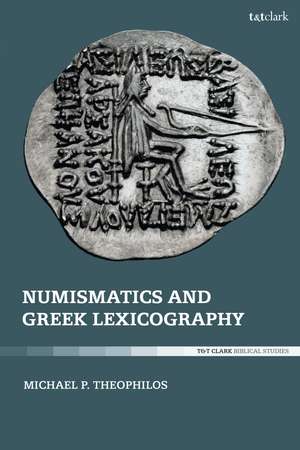Numismatics and Greek Lexicography
Autor Michael P. Theophilosen Limba Engleză Paperback – 28 iul 2021
Preț: 219.09 lei
Preț vechi: 275.63 lei
-21% Nou
Puncte Express: 329
Preț estimativ în valută:
41.92€ • 43.88$ • 34.89£
41.92€ • 43.88$ • 34.89£
Carte tipărită la comandă
Livrare economică 31 martie-14 aprilie
Livrare express 22-28 februarie pentru 82.56 lei
Preluare comenzi: 021 569.72.76
Specificații
ISBN-13: 9780567701978
ISBN-10: 0567701972
Pagini: 296
Ilustrații: 76 bw illus
Dimensiuni: 156 x 234 x 19 mm
Greutate: 0.42 kg
Editura: Bloomsbury Publishing
Colecția T&T Clark
Locul publicării:London, United Kingdom
ISBN-10: 0567701972
Pagini: 296
Ilustrații: 76 bw illus
Dimensiuni: 156 x 234 x 19 mm
Greutate: 0.42 kg
Editura: Bloomsbury Publishing
Colecția T&T Clark
Locul publicării:London, United Kingdom
Caracteristici
The incorporation of numismatic material culture opens new interpretive vistas and provides cogent solutions to several noted lexicographic dilemmas (examined in the book's case studies)
Notă biografică
Michael P. Theophilos is Associate Professor of Biblical Studies and Ancient Languages in the Faculty of Theology and Philosophy at the Australian Catholic University, Australia.
Cuprins
List of FiguresList of TablesAcknowledgementsList of AbbreviationsPart One:Chapter 1: IntroductionChapter 2: The History of CoinageChapter 3: The Study of CoinageChapter 4: Critical Issues in the Appeal to CoinagePart Two:Chapter 5: FilosChapter 6: KarpoforosChapter 7: NeokorosChapter 8: Thoes, Eleutheria, Eirini Kai Asfaleia, Kaveiros Chapter 9: CharaktirChapter 10: KtistisChapter 11: Vasileus VasileonConclusionBibliographyIndex of Modern AuthorsIndex of Scripture References and Other Ancient Sources
Recenzii
Significant ground-breaking books such as this are rare and the importance of this book cannot be overstated. It is clear, detailed, and correct in pointing out an unquestionable deficiency in New Testament lexicography making it an excellent book for anyone interested in biblical Greek.
The case studies offer significant contributions, and the book as a whole makes a commendable pro-seminar textbook for scholars and graduate students.
The methodological discussion has the potential to help shape the future of Greek lexicography and, especially, the tools upon which students and scholars rely. Theophilos's study is sure to leave an impression on the field. Scholars of the New Testament and early Christianity are in his debt.
'Theophilos' invaluable, original and innovative research breaks new ground methodologically in bringing together the usually disparate specialties of numismatics, lexicography and New Testament studies. All three areas will substantially benefit from this scholarly, robust and up to date critical appraisal and the subsequent series of case studies. It is highly recommended for numismatists and Neutestamentler, and will extend lexicographers beyond their usual recourse to papyrology and epigraphy.
In this eloquent volume, the author equips his reader to appreciate and to understand two long established and technical fields of study: numismatics and lexicography. New Testament scholars are encouraged to recognise not only the significant contribution that coin inscriptions can make to lexicography, but also how such insights into the Greek language might illuminate New Testament Texts. Theophilos combines a sophisticated approach with critical rigor and lucid accessibility.
This book is an invaluable contribution to the field of New Testament vocabulary studies and lexicography, a "must read" for novices and specialists alike. It eruditely and amply exemplifies the shortcomings in our lexicons and translations, all of which combine to hinder our full understanding. Essential for improving this state of affairs is a focus on the wealth of non-literary evidence for the contemporary language, most of it not yet properly explored. Coins have been the most neglected; Theophilos remedies this gap, makes exciting a subject that at first sight might appear dry and inaccessible, and leads the way forward with further discoveries.
The case studies offer significant contributions, and the book as a whole makes a commendable pro-seminar textbook for scholars and graduate students.
The methodological discussion has the potential to help shape the future of Greek lexicography and, especially, the tools upon which students and scholars rely. Theophilos's study is sure to leave an impression on the field. Scholars of the New Testament and early Christianity are in his debt.
'Theophilos' invaluable, original and innovative research breaks new ground methodologically in bringing together the usually disparate specialties of numismatics, lexicography and New Testament studies. All three areas will substantially benefit from this scholarly, robust and up to date critical appraisal and the subsequent series of case studies. It is highly recommended for numismatists and Neutestamentler, and will extend lexicographers beyond their usual recourse to papyrology and epigraphy.
In this eloquent volume, the author equips his reader to appreciate and to understand two long established and technical fields of study: numismatics and lexicography. New Testament scholars are encouraged to recognise not only the significant contribution that coin inscriptions can make to lexicography, but also how such insights into the Greek language might illuminate New Testament Texts. Theophilos combines a sophisticated approach with critical rigor and lucid accessibility.
This book is an invaluable contribution to the field of New Testament vocabulary studies and lexicography, a "must read" for novices and specialists alike. It eruditely and amply exemplifies the shortcomings in our lexicons and translations, all of which combine to hinder our full understanding. Essential for improving this state of affairs is a focus on the wealth of non-literary evidence for the contemporary language, most of it not yet properly explored. Coins have been the most neglected; Theophilos remedies this gap, makes exciting a subject that at first sight might appear dry and inaccessible, and leads the way forward with further discoveries.
